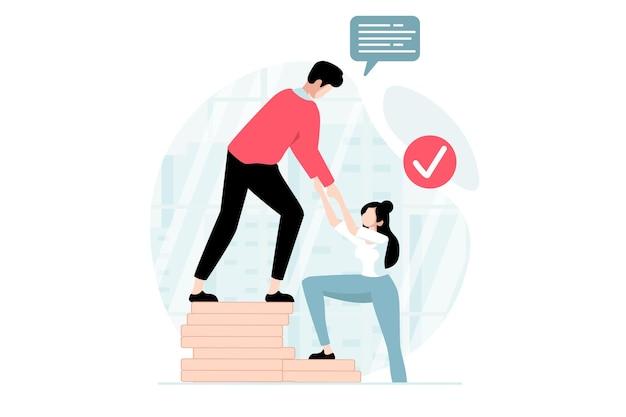As a leader, coach, or manager, one of the essential skills you need to cultivate is coaching and developing others. Whether you’re coaching a sports team, managing employees, or fostering personal growth, the ability to inspire, teach and motivate others is crucial. In this blog post, we’ll explore the basics of coaching and development, the goals of coaching and developing others, and some best practices and coaching practice examples that can help you achieve success. We’ll also discuss how coaches and managers can develop others in the workplace while maintaining a positive work environment. So, How do you coach and develop others? Read on to find out!
Why Coaching and Developing Others is Like Raising a Pet
Being a coach is like raising a pet. Just like pets, your mentees need guidance, care, and training. You have to start by figuring out their personality, their strengths, their weaknesses, and how they can grow. You have to tailor your approach to their unique needs just like you would with a pet.
Understand Their Needs
Pets have individual needs too. Some need more attention than others, some need more exercise, some require special diets, and others need more socializing. Similarly, mentees have different needs as well. Some need more hands-on guidance while others need more independence. You need to figure out what works best for them and adjust accordingly.
Positive Reinforcement
Pets need positive reinforcement to learn new tricks, and mentees need encouragement to grow. Both need to feel like they are making progress. Positive feedback keeps them motivated and helps build their confidence.
Consistency is Key
Just like with pets, consistency is the key to success when coaching and developing others. You need to have a consistent approach to keep them engaged and motivated. If you keep changing your approach, your mentees might get confused, frustrated, or lose interest.
Addressing Bad Behavior
Pets sometimes act up, and so do mentees. You need to correct their behavior by giving them constructive feedback. Addressing their bad behavior builds their character, teaches them the right way to do things and prepares them for future challenges.
Enjoy the Process
Finally, just like with pets, coaching and developing others can be a lot of fun. Seeing your mentees grow and develop can be very rewarding. It’s like watching your pet learn a new trick or wag their tail. Enjoy the process, have fun, and you may end up with a friend for life.
In conclusion, coaching and developing others require a certain level of thoughtfulness and care, just like raising a pet. By understanding your mentee’s needs, providing positive reinforcement, being consistent in your approach, addressing their bad behavior, and having fun, you’ll be able to achieve great results in no time.
Coaching and Development: The Secret to Unlocking Your Employees’ Potential
When it comes to coaching and developing your employees, it’s understandable to feel overwhelmed or unsure where to start. But the reality is that investing in your team’s growth and success will pay off in dividends for both your company and individual employees. Here are some actionable tips to help you become a pro at coaching and development:
Start by Identifying Areas for Improvement
The first step to effective coaching and development is identifying areas where your employees could improve. You can’t help someone grow if you don’t identify what they need help with. Don’t be afraid to have an honest conversation with your employees and ask them what they think they need to work on.
Set Goals and Expectations
Once you’ve identified areas for improvement, set specific, measurable goals for your employees to work toward. This gives them something concrete to strive for and helps keep them focused and motivated. Clear expectations help employees understand what you expect from them and how they can meet or exceed those expectations.
Provide Resources and Support
Coaching and development aren’t just about telling someone what to do. It’s important to provide the resources and support they need to succeed. This could include training programs, external coaching, or even just giving them the time and space to work on their goals. Remember, investing in your employees is an investment in your company’s success.
Practice Active Listening
As a coach, it’s important to be an active listener. This means not just hearing what your employee is saying, but actively engaging with them and asking questions. Reflect back on what they’ve said to ensure that you understand their perspective thoroughly. Being an active listener helps build trust and shows your employees that you truly care about their success.
Celebrate Wins
Finally, don’t forget to celebrate your employees’ successes! When someone meets or exceeds their goals, take the time to acknowledge and celebrate their hard work. This not only makes them feel appreciated, but it also reinforces the idea that coaching and development are valuable parts of your company’s culture.
Coaching and development are crucial for both individual and company success. By following these tips, you’ll be well on your way to unlocking your employees’ potential and achieving your goals.
Coaching Practice Examples
Developing others involves effective coaching practices that can help individuals achieve their professional goals, reinforce long-term learning, and improve performance. Here are some coaching practice examples to consider:
Active Listening
The most successful coaches are those who actively listen to their team members. Encouraging employees to speak freely, ask questions, and share their thoughts is vital to developing trust and building a strong coach/coachee relationship. Active listening requires undivided attention and focus, so put away your phone, avoid distractions, and give your employees the respect they deserve.
Setting Clear Goals
Before embarking on any coaching session, it’s essential to establish clear goals. What does the employee hope to achieve? Is this a short-term or long-term goal? Specific and measurable goals help ensure that progress is being made and keep both parties focused on the end result.
Providing Feedback
Providing feedback is a crucial part of the coaching process. Whether it’s positive or constructive, feedback helps individuals grow, learn and improve. Done effectively, feedback should recognize and reinforce positive behaviors while identifying areas for improvement while highlighting potential solutions.
Co-Creating Action Plans
Co-creating action plans ensures the coachee gets involved in the process, taking ownership of their development. By involving individuals in the development process, they are more likely to be motivated and buy into the learning process.
Celebrating Success
Celebrating successes at every level helps individuals to stay motivated and feel valued. Acknowledge and celebrate successes and achievements, however small, to reinforce good behavior and positive performance.
By employing these coaching practice examples, you can help individuals remain focused, accountable, and motivated on the path to achieving their professional goals. Remember, effective coaching requires time, patience, and dedication to the process. So try to have fun with it, be innovative, and don’t be afraid to try new ideas.
Coaching Best Practices PDF
As a coach, it’s crucial to have a solid understanding of the best practices for coaching your team or developing others. Fortunately, there are resources available in the form of coaching best practices PDFs.
What is a coaching best practices PDF
A coaching best practices PDF is a comprehensive guide that outlines the key principles and strategies for effective coaching. It’s a must-have resource for any coach looking to improve their coaching skills and better support their team.
What should you look for in a coaching best practices PDF
When searching for a coaching best practices PDF, it’s important to look for a guide that covers a wide range of topics, including:
- Communication and listening skills
- Building trust and rapport with team members
- Goal-setting and performance management
- Feedback and coaching techniques
- Team development and motivation
Additionally, the guide should be easy to read and understand, with practical examples and tips that you can implement immediately.
Where can you find a coaching best practices PDF
There are many resources available online where you can find coaching best practices PDFs. Some great resources include:
- Coaching and mentoring organizations
- Human resources and leadership development websites
- Business and management consultants
In conclusion, a coaching best practices PDF is an invaluable resource for any coach looking to improve their skills and better support their team. With a little research, you can find a guide that covers all the essential topics and provides practical tips and examples to help you become a more effective coach.
Coaching Sports: When Yelling Results in Wins
As a coach, it can be challenging to know how to get the best out of your team. One approach is to yell until they do what you want. Does it work? Not sure. But it’s worth a try.
The Benefits of Screaming
When your team is on the field, yelling can do wonders for their success. It will motivate them, fire them up, and get them ready for the challenge ahead. If you see someone slacking off, yelling will snap them back into reality and remind them that they’re here to win!
Make it Personal
To make sure your team knows that you’re serious, make the yelling personal. Point out someone who is not doing their best; make eye contact and let them know that they need to step up. Having a personal touch will make them feel as though you care about their success as much as they do.
Timing is Key
Don’t yell during downtime, such as during halftime, after the game, or during practice. Save it for when it matters the most. Yelling is like a precious commodity; use it sparingly but effectively.
Don’t Overdo it
As effective as yelling can be, you don’t want to overdo it. Yelling too much can desensitize your team to its effects. Reserve your yelling for high-pressure situations, and you’ll see the results you’re looking for.
While coaching sports can be a challenge, yelling at your team can help them succeed. However, it’s essential to keep things personal, use yelling sparingly, and never overdo it. With the right approach, yelling can be your secret weapon for success.
How to Coach and Develop Others: Tips and Tricks for Success
Coaching others can be a challenging yet rewarding experience. Whether you’re a supervisor, manager, or coach, helping others reach their full potential is a critical part of your job. So how do you go about coaching and developing others? Here are some tips and tricks to help you succeed:
1. Set Clear Expectations
One of the most important things you can do when coaching others is to set clear expectations. Be specific about what you want them to achieve and by when. This will help them understand what they need to do to be successful and avoid any confusion or misunderstandings.
2. Provide Real-Time Feedback
Another critical aspect of coaching is providing real-time feedback. Don’t wait for a performance review to give feedback – provide it regularly, so your employees know how they are doing. Be specific about what they’re doing well and where they can improve.
3. Focus on Strengths
When coaching and developing others, it’s easy to get caught up in fixing weaknesses. However, it’s essential to focus on their strengths as well. Celebrate their successes and encourage them to leverage their strengths to achieve their goals.
4. Create a Supportive Environment
Creating a supportive environment is key to developing others. Be approachable and open to feedback, encourage questions, and foster a culture of learning. Encourage your team to come to you with their concerns, feedback, and ideas.
5. Provide Opportunities for Growth
Providing opportunities for growth is critical to developing others. Help your employees identify areas where they can improve and provide them with training and development opportunities. This will help them grow both personally and professionally.
6. Lead by Example
Finally, one of the most effective ways to coach and develop others is to lead by example. Practice what you preach, and show your team what great coaching looks like. Be a role model, and they will follow in your footsteps.
In conclusion, Coaching and developing others is an essential aspect of any leadership role. With the right approach, you can help your team achieve their full potential and reach new levels of success. Remember to set clear expectations, provide real-time feedback, focus on strengths, create a supportive environment, offer opportunities for growth, and lead by example. By doing so, you’ll be well on your way to success as a coach and leader.
What’s up with Coaching and Developing Others Goals Anyway
Coaching and developing others is a common buzzword these days, with every organization emphasizing its importance. But what exactly is coaching, and why is it essential to develop others, you might ask?
Coaching: It’s not Just a Sports Term!
Coaching is not just limited to the sports industry; it’s a process that helps individuals achieve their goals. It’s a collaborative process where the manager guides the employee to develop their skills, and abilities to improve job performance.
Coaching is all about empowering the employee to take ownership of their work and performance, rather than being told what to do constantly. It involves listening carefully, understanding their perspective, and guiding them in the right direction.
Developing Others: The Future is Here!
Developing others is crucial as it helps employees unleash their full potential. Training and mentoring are an essential part of the development process that enables employees to work towards their personal and professional goals.
Developing others helps organizations create a pool of talented employees who can take up leadership positions in the future. It’s about creating a culture of continuous learning and development that has a positive impact on the overall health of the organization.
Why are Coaching and Developing Others Goals Essential
Coaching and developing others goals are essential because they increase employee engagement and retention, improve productivity, and bridge skill gaps. Employees who receive coaching and mentoring support are more satisfied with their jobs, leading to higher retention rates.
Coaching also helps employees earn promotions and increases their confidence in taking up new challenges, resulting in increased productivity. Developing others helps bridge skill gaps and promote a culture of continuous learning that makes staff more efficient and effective, leading to better business outcomes.
Wrapping it Up!
In conclusion, coaching and developing others goals are crucial for the growth and success of an organization. Coaching helps employees achieve their potential and improve their performance, while development helps bridge skill gaps and promote a culture of continuous learning. By implementing coaching and development strategies, organizations can cultivate a skilled and motivated workforce that contributes to business success.
Examples of Developing Others in the Workplace
If you’re a manager, then one of your primary responsibilities is to develop your team members. But you don’t need to be a manager to develop others in the workplace; anyone can do it. Here are a few examples:
Mentorship Programs
A mentorship program is a structured program that pairs less experienced employees with more experienced ones. Mentors provide guidance and advice to their mentees, helping them develop their skills and achieve their career goals. As a mentor, you can help your mentee by offering feedback, sharing your knowledge and experience, and helping them network.
Training and Development Programs
Training and development programs are an excellent way to develop your team members. They help employees learn new skills and improve existing ones. It’s crucial to tailor the training to the employee’s needs, goals, and learning style.
Stretch Assignments
Stretch assignments are tasks or projects that push employees outside their comfort zone. They help employees build new skills and gain confidence. As a manager, you should identify your team members’ strengths and give them stretch assignments that will challenge them.
On-the-Job Training
On-the-job training is a type of training that takes place on the job. It’s an excellent way to develop your team members’ skills while they’re working. You can teach them new skills or techniques, or you can have them observe and work alongside more experienced team members.
Coaching and Feedback
Coaching and feedback are critical to developing your team members. As a manager, you should offer regular feedback on your team members’ performance. It’s also crucial to be a coach and help them improve their skills and achieve their goals.
Developing others in the workplace requires effort, time, and patience. But it’s worth it. When you invest in your team members’ development, you help them reach their full potential, and you create a more productive and engaged workforce.


